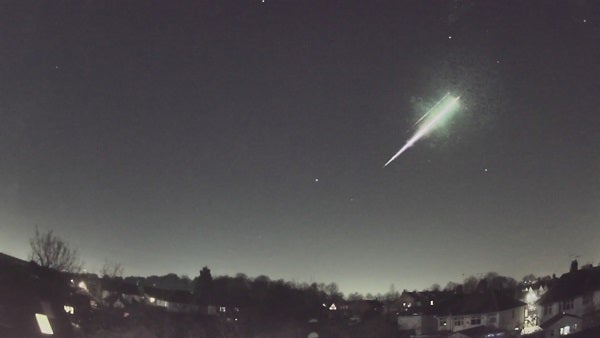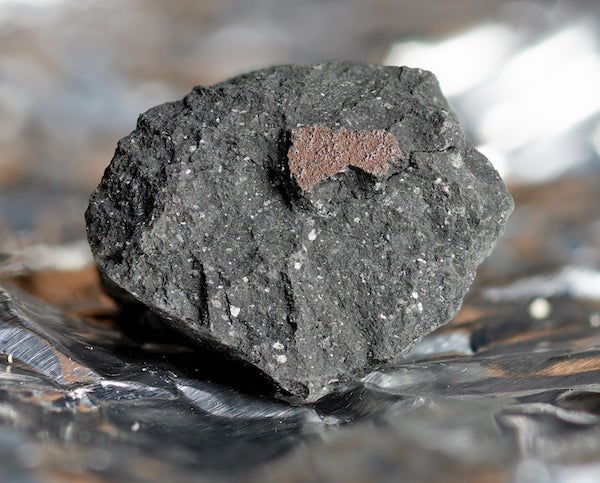Just before 10 P.M. local time on Feb. 28, a dazzlingly bright meteor traversed the U.K.’s western sky, glowing for about six seconds. It was so bright, in fact, it was termed a fireball. Hundreds of people who happened to glimpse the sight took to social media to report what they saw, wondering if their eyes had been playing tricks on them — or even if they had just seen a visitor from outer space.
But for astronomers, this was a special and rare treat for another reason: It was a chance to search for any pieces left behind.
From meteor to meteorite
We are all familiar with meteors — the flashes of light produced when a piece of rock or dust from space burns up in our atmosphere. Maybe you’ve even enjoyed watching meteor showers throughout the year. But fireballs are rarer. These exceptionally bright meteors streak across the sky with a magnitude greater than –4. That’s about as bright as Venus at its best.
If a meteor doesn’t completely burn up on entry, anything left falls to Earth as a meteorite. Like the larger space rocks that spawn them, meteorites range widely in size. The 1920 meteorite that landed in Hoba, Namibia, for instance, weighs 66 tons (60 metric tons), while the 1949 Beddgelert meteorite that landed in North Wales in the U.K. weighs only 28 ounces (794 grams). But every piece, no matter how small, tells a unique story.
Catching the fall
Of the approximately 65,000 known meteorites, only 1,206 were seen falling to Earth.
To increase this number, the Natural History Museum in London leads and operates the U.K. Fireball Alliance (UKFAll), which employs a huge network of cameras aimed at the skies above the U.K., recording the bright streaks these rocky fragments leave behind. The pictures taken as part of this project provide vital information about the paths these rocks take through our atmosphere. By comparing images taken from different locations, observers can trace the meteors path to help deduce where surviving fragments may have landed. And using this technique, UKFAll aims to recover such meteorites.
Led by volunteers and staff at the Natural History Museum London, UKFAll is a collaboration between six key camera networks: five operate in the U.K. and Europe, while a sixth spans the globe. Thanks to this collaboration, UKFAll was able to calculate where pieces of the most recent U.K. fireball might have landed, as well as determine where in the asteroid belt the original space rock came from, based on its trajectory when entering the atmosphere.
On the night of the fireball, over a thousand reports came filtering into the U.K. Meteor Observing Network (UKMON), part of UKFAll’s network. These were a mixture of eyewitness reports, footage from doorbell cameras, and photographs. Dedicated UKMON cameras captured this unexpected visitor, too.
When footage showed the fireball fragmenting, hopes were high that some material would be found on the ground. Using information from this network of cameras and footage from the public, UKFAll recreated the fireball’s flight path to determine possible landing sites in Gloucestershire. Mary McIntyre, an active UKMON participant, tells Astronomy, “This is a huge win for citizen science in that so many cameras caught the event across so many networks, and everybody worked together quickly to calculate the strewn field [the area where debris might have landed].”
An exciting find
On March 1st, the Natural History Museum confirmed in a press release that pieces of the meteorite were found on a residential driveway in Winchcombe in the Cotswolds. The black, charcoal-like fragments were quickly retrieved by the Wilcock family, who owns the property. Several other fragments were discovered scattered around the local area. The museum has obtained nearly 11 ounces (300 g) of material from what’s now officially named the Winchcombe meteorite.
Dated at around 4.6 billion years old, this cosmic sample is especially significant because it’s a type of meteorite called a carbonaceous chondrite. These are some of the most pristine, unaltered material in the solar system. Astronomers believe carbonaceous chondrites come from asteroids in the outer regions of the main belt. And their rare composition of minerals and organic compounds — including amino acids — can provide valuable information about the origin of our solar system, the formation of the planets, and the building blocks of life. Of the thousands of meteorite samples found on Earth, only about 50 are carbonaceous chondrites.
According to the Natural History Museum, it’s been 30 years since a meteorite was last recovered in the U.K., and these fragments are the first known carbonaceous chondrite discovered in the country. Plus, the pieces are in such good condition that they are comparable to the samples returned by space missions, both in quality and quantity.
Sara Russell, a Merit Researcher in Cosmic Mineralogy at the Museum, advised on how to care for the meteorite after it was located. For context, the Japanese Hayabusa2 mission recently returned 0.16 ounce (4.5 g) of material from asteroid Ryugu, which the museum is also helping characterize. And Russell says “The Winchcombe meteorite fall is very timely, as the rock is similar to Ryugu in many ways, and we can use the meteorite to rehearse for mission analyses.”
Ashley King of the museum’s Department of Earth Sciences, who was among the first on the scene when the meteorite was discovered, said, “The opportunity to be one of the first people to see and study a meteorite that was recovered almost immediately after falling is a dream come true!”
After their dramatic and unforgettable arrival, the meteorite fragments that rained down on Winchcombe will now undergo testing so researchers can identify their exact chemical makeup. This testing will also allow them to confirm the validity of the samples and better understand their scientific significance.
Although the bright flash that caught the public’s attention is long gone, the story of the Winchcombe meteorite is just beginning. And for the scientists studying these rare space rocks, thrilling times are ahead.











